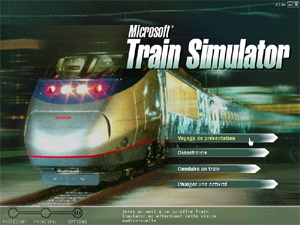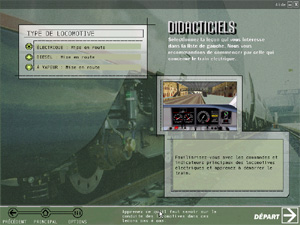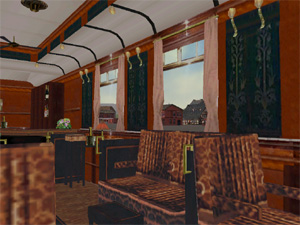
 |

|
| ActiveWin: Reviews | Active Network | New Reviews | Old Reviews | Interviews |Mailing List | Forums |
|
|
|
|
|
DirectX |
|
ActiveMac |
|
Downloads |
|
Forums |
|
Interviews |
|
News |
|
MS Games & Hardware |
|
Reviews |
|
Support Center |
|
Windows 2000 |
|
Windows Me |
|
Windows Server 2003 |
|
Windows Vista |
|
Windows XP |
|
|
|
|
|
|
|
News Centers |
|
Windows/Microsoft |
|
DVD |
|
Apple/Mac |
|
Xbox |
|
News Search |
|
|
|
|
|
|
|
ActiveXBox |
|
Xbox News |
|
Box Shots |
|
Inside The Xbox |
|
Released Titles |
|
Announced Titles |
|
Screenshots/Videos |
|
History Of The Xbox |
|
Links |
|
Forum |
|
FAQ |
|
|
|
|
|
|
|
Windows XP |
|
Introduction |
|
System Requirements |
|
Home Features |
|
Pro Features |
|
Upgrade Checklists |
|
History |
|
FAQ |
|
Links |
|
TopTechTips |
|
|
|
|
|
|
|
FAQ's |
|
Windows Vista |
|
Windows 98/98 SE |
|
Windows 2000 |
|
Windows Me |
|
Windows Server 2002 |
|
Windows "Whistler" XP |
|
Windows CE |
|
Internet Explorer 6 |
|
Internet Explorer 5 |
|
Xbox |
|
Xbox 360 |
|
DirectX |
|
DVD's |
|
|
|
|
|
|
|
TopTechTips |
|
Registry Tips |
|
Windows 95/98 |
|
Windows 2000 |
|
Internet Explorer 5 |
|
Program Tips |
|
Easter Eggs |
|
Hardware |
|
DVD |
|
|
|
|
|
|
|
ActiveDVD |
|
DVD News |
|
DVD Forum |
|
Glossary |
|
Tips |
|
Articles |
|
Reviews |
|
News Archive |
|
Links |
|
Drivers |
|
|
|
|
|
|
|
Latest Reviews |
|
Xbox/Games |
|
Fallout 3 |
|
|
|
Applications |
|
Windows Server 2008 R2 |
|
Windows 7 |
|
|
|
Hardware |
|
iPod Touch 32GB |
|
|
|
|
|
|
|
Latest Interviews |
|
Steve Ballmer |
|
Jim Allchin |
|
|
|
|
|
|
|
Site News/Info |
|
About This Site |
|
Affiliates |
|
Contact Us |
|
Default Home Page |
|
Link To Us |
|
Links |
|
News Archive |
|
Site Search |
|
Awards |
|
|
|
|
|
|
|
Credits |

|
Product: Train Simulator |
Driving A Train Without License
|
Table Of Contents |
If you thought that driving one of the six real trains available in Microsoft Train Simulator will be easy, youíre definitely wrong. Indeed you have to maneuver each command with precision. Once youíve launched the game youíll discover a sober but efficient interface thatíll show the different activities you can experience with the game. The first thing youíll have to do is to train (no pun intended) your driving skills using the tutorial. This integrated helpful & detailed tutorial will teach you everything you have to know to drive a train, for the first time, correctly, including commands' manipulations.

Microsoft Train Simulator
Interface: Welcome Screen, Tutorial & Settings (click to enlarge)
To drive an electric or diesel motor coach, youíll have to release the brakes, set the reverse command to forward or backward and then you can put the gas on to start the train. But things are much more complex when it comes to driving a steam locomotive. Those actions can be done using the mouse but youíll probably prefer using the keyboard shortcuts since, strangely enough, the mouse doesnít always work with the cabinís commands (itís very hard for example to set the reverse lever in the Acela Express). If you forget something, the built-in checklist feature will help you perform the necessary actions to start cruising. However since the reality is the game if you go full speed youíll never be able to stop the train at the right time nor to respect the driving signs. Indeed this simulation will remind you, youíre driving a train that weighs several tons and as a result a braking isnít instantaneous.
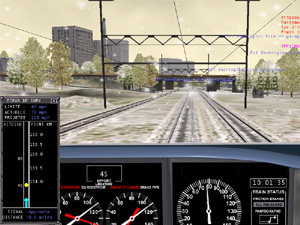
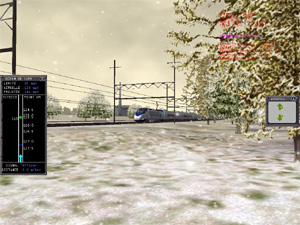
Microsoft Train Simulator:
Driving & Watching (click to enlarge)
To add to the high reality level, there are plenty of signals (that are different for each line) along the railway youíll have to respect if you want to avoid crashes. For example if you donít slow down to the speed indicated by the signal, while arriving in a curve your train has a good chance of being derailed. Thankfully Microsoft has included with the game a small leaflet explaining the meaning of the various train signals in the various countries youíll explore. Also to be aware of the upcoming speed limitations you can display the railway indicator window thatíll show the limited speed for each portion of the circuit as well as the switch. When driving an electric train, like the Acela Express, if your train goes to fast, the emergency brake system will be automatically enabled and you train will simply stop. If ever you take a curve too fast or fail to stop at the end of the tracks, the train will derail. However the problem is that the graphics engine fails to render crashes properly. Indeed sometimes when your train has just got off the railway youíll see it pass under the ground or over walls instead of crashing properly into the solid surface in front of it.
Available Trains & Circuits
As stated before there are six trains and circuits available to play. The available trains are: Amtrak Acela Express, Venice Simplon Orient-Express, Kyushu, Odakyu Series 7000, Burlington Northern Santa Fe and the legendary Flying Scotsman. Each train features a reproduction of the real driving cabin offering ultra detailed and interactive controls: from the steam regulator, to the brake system youíve got full control over the machine. The available train circuits are: East North US Corridor, Austrian Alps, Hisatsu Japanese line (on the Kyushu Island), Mont Fuji Japanese line, Burlington Northern Santa Fe and United Kingdom campaign.
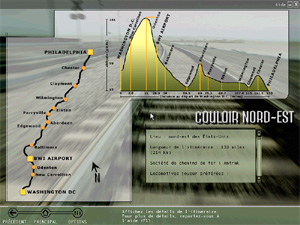

Microsoft Train Simulator
North Corridor Map & GŲlsdorf 380 Technical Sheet (click to enlarge)
Being a European citizen Iím disappointed by the too restricted number of trains offer by Train Simulator. What about the German ĎICEí? What about the Japanese ĎShinkansení? Worst as Iím French before everything, itís a real regret to see that the French trains that are used to break several worldwide speed records arenít available in the game: for instance in 1960 the BB9200 was the first commercial train to hit speed up to 200km/h, while in 1980 the TGV (Train ŗ Grande Vitesse = High Speed Train) smashed out every speed record with commercial connections reaching 300km/h (equal to 186mi/h). I donít speak about the latest speed record established by the TGV in the 90ís at 515,3km/h (equal to 320mi/h). If thereís one train that shouldnít be omitted in Train Simulator it was surely the Alsthom/SNCF TGV.
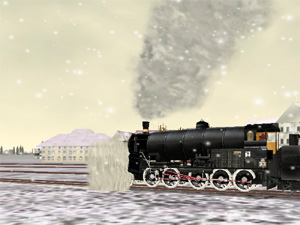
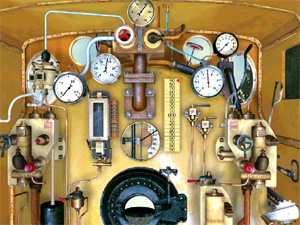
Driving a Steam train
(click to enlarge)
Some will argue the game features an open architecture so everybody will be able to build their own trains just like in Flight Simulator but the Ďbasicí train enthusiast isnít obviously a 3D champion designer. While the built-in editor will help you create both trains and circuits, the process remains quite complex so we really hope Microsoft will soon provide bonus trains & circuits for free download on the Train Simulator website.
Driving
Once youíve launched your train you can watch, from the window, the landscape rolling by. The graphics engine of the game renders highly detailed and realistic trains while the moderately animated landscape is correct (even if we noticed some glitches with rail or road joins). Just like in a real train you can choose to enable or disable the headlights: but on the US circuit when youíre in a tunnel despite the headlights are on the tunnelís interior will remain totally black & dark (it seems lights have no effects in tunnels). If thatís not enough you can sit in a train car and experience the passengers view. When doing so, youíll notice youíre the only passenger in the car which is regrettable: Microsoft didnít think that a regular car (and a station) is usually full of passengers. Inside the car, you have a 180į view you can change with the keyboard arrows buttons. Now the best thing is the external view: enabling this mode will show your train (under different cameras angle you can change) charging up on the rail way with the whole landscape passing by. Itís even possible to zoom in/out or rotate around the train. Thatís pretty cool! But it can get boring very soon. The graphics engine features several bugs: for example when you crash your train some cars become suddenly transparent and disappear under the ground: we really hope Microsoft will fix those kinds of issues with an upcoming patch. During your trip, youíll listen to real sounds that trains produce, like the well known whistling of a steam train, the diesel engineís noise, etc.: those high quality sounds were recorded on real trains adding to the thrill of the driving. Youíll even be able to hear the difference between wood or concrete ties! When exploring a railway you can choose the rail switch your train should take using a keyboard hotkey and you can even add or remove wagons to your train.
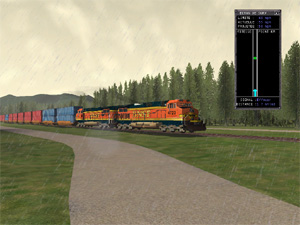
Being a passenger or a
watcher (click to enlarge)
To spice up the game, there are several missions (around 60) available including: respecting a timetable to deliver and pick up freight or passengers while encountering unexpected obstacles (like rocks collapsing on the rail), use extra engine to get a 50 cars train through the Marias pass during a snow tempest and more. You can always choose to create your own scenarios. And if you donít want to annoy yourself with missionsí constraints, the free driving mode is waiting for you: here you drive your train as you want and youíll discover new circuit areas scenarios donít show: however this can be quite boring since thereís almost nothing to do except watchÖ

